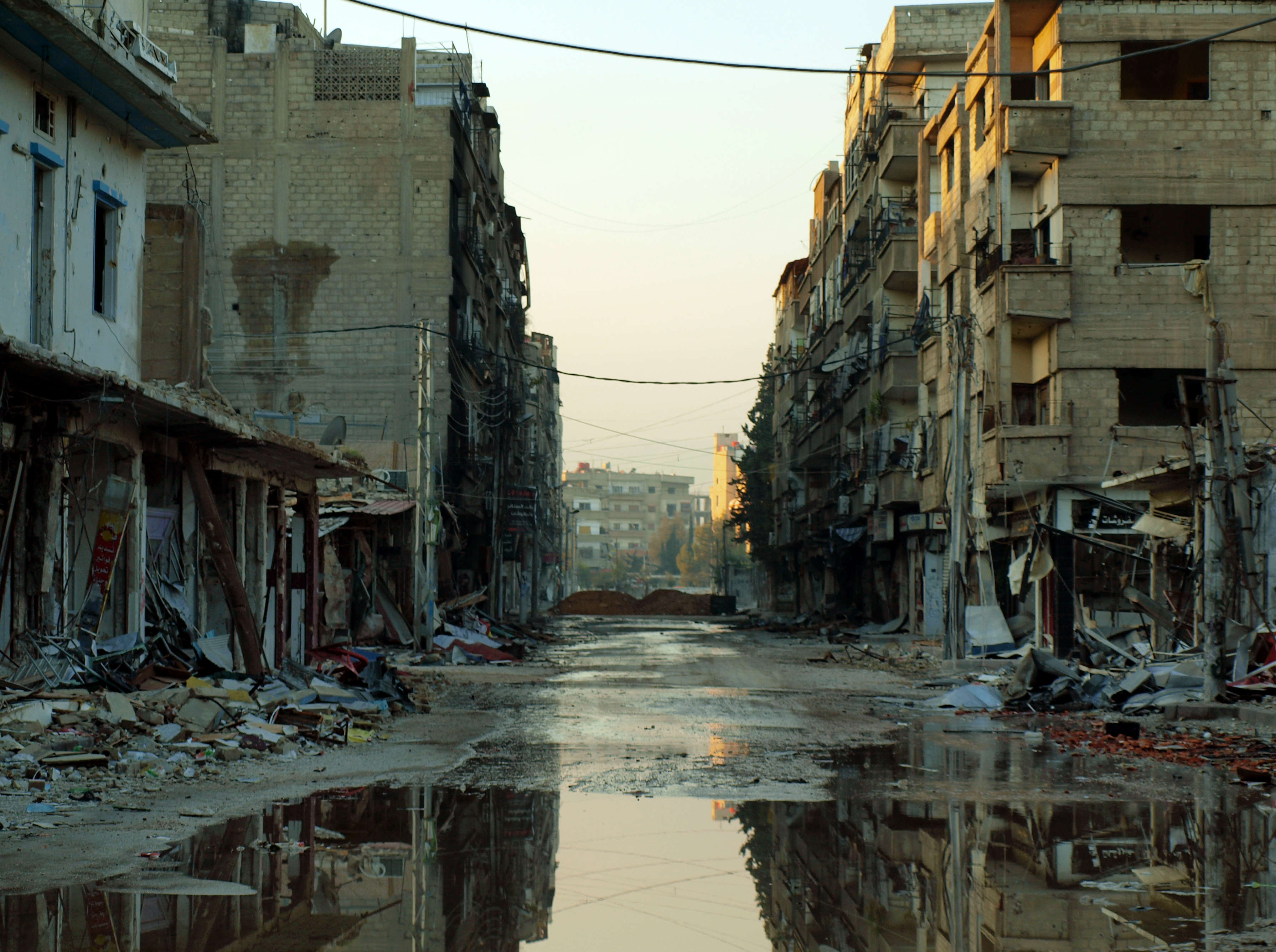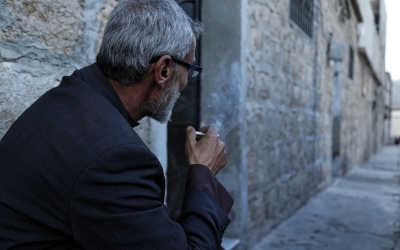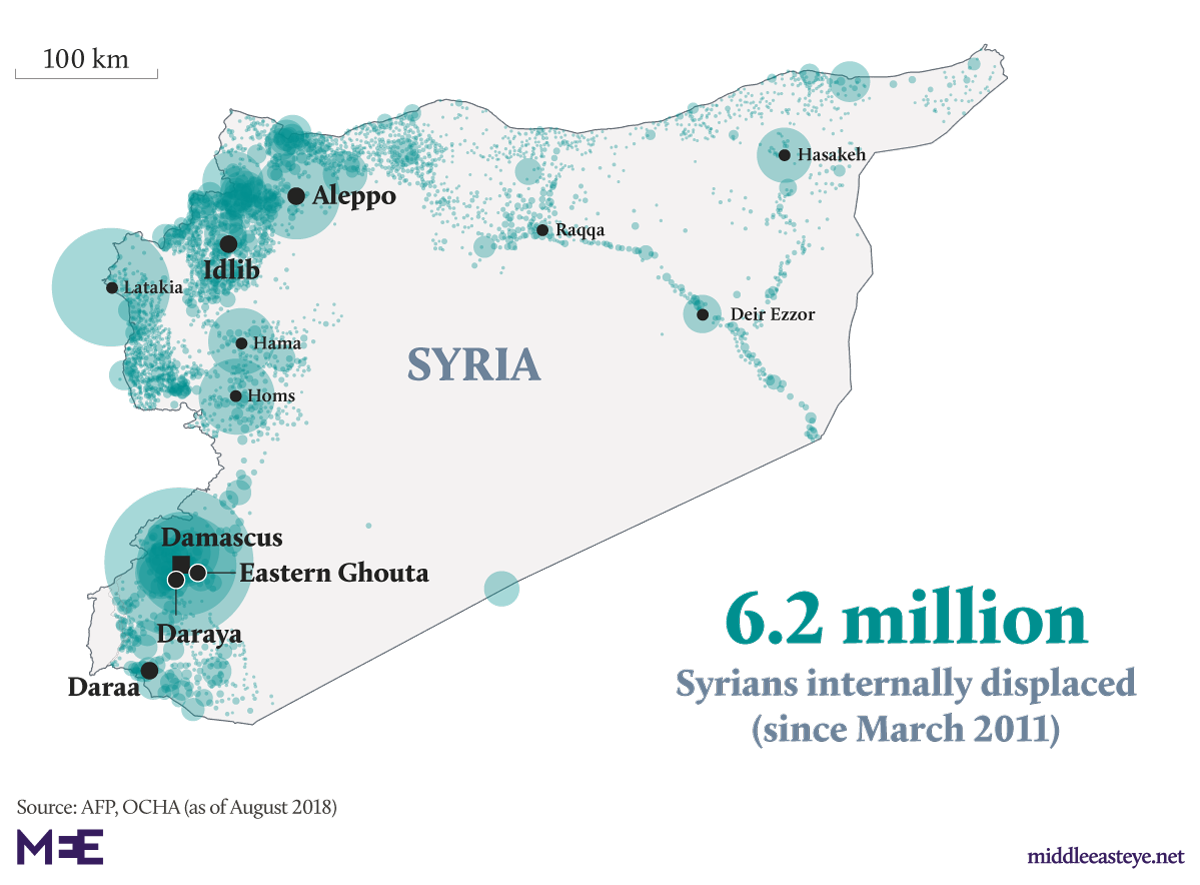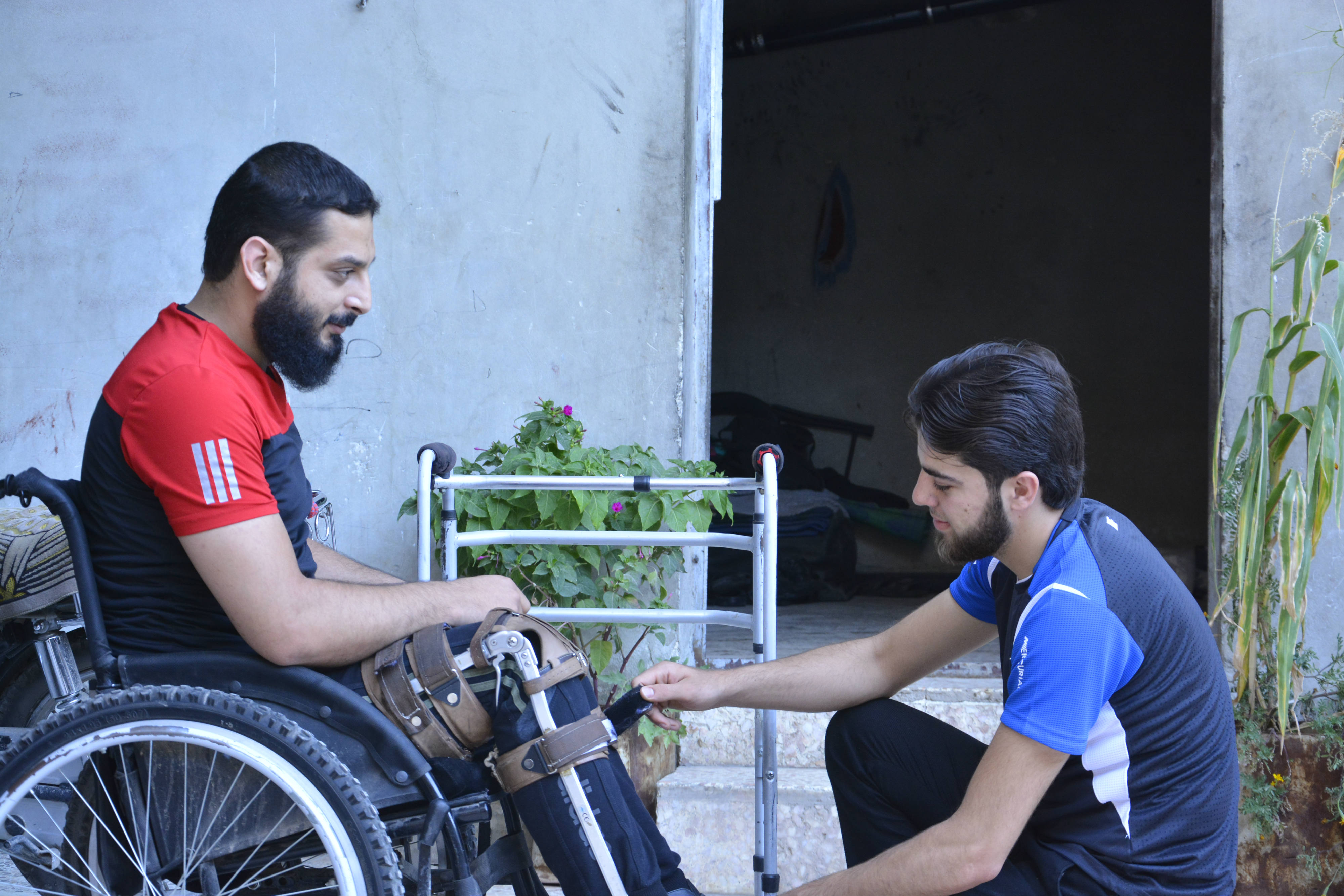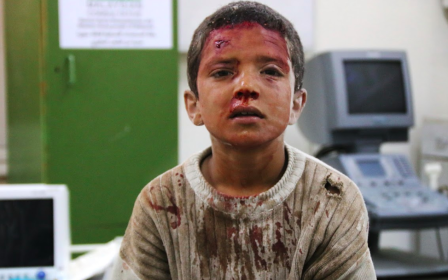Protest, torture, siege, displacement: The Syrian revolution through a rebel's eyes
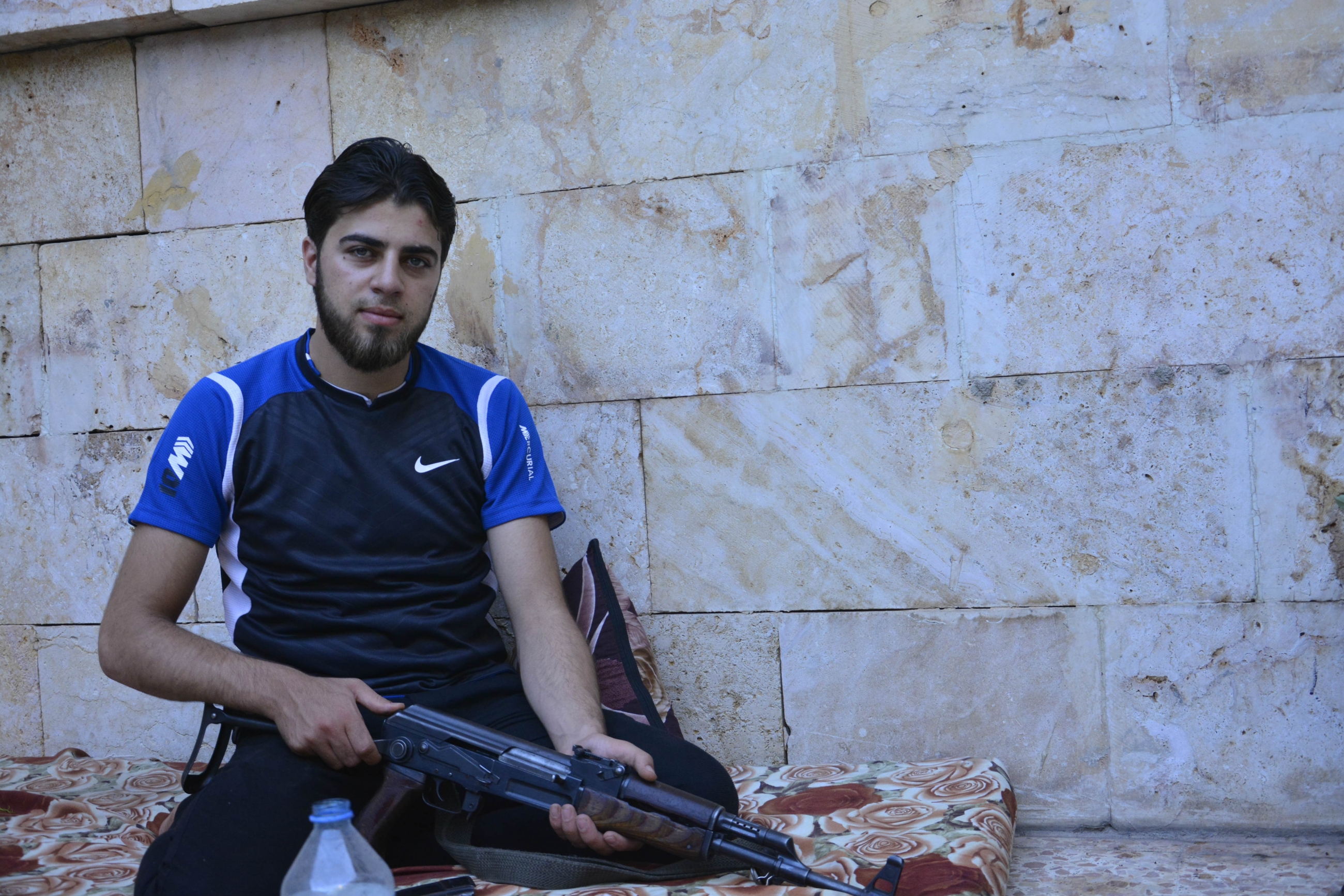
In the dusty backyard of a small house with cracks down its walls sits Obada Dabbas, cooking eggs.
Despite suffering from old wounds, a broad smile is drawn across his face.
Dabbas's story is the story of the Syrian revolution. He has at turns been protester, detainee, rebel fighter and one of 14 million Syrians who have been displaced from home.
Though it has been eight years since demonstrations against President Bashar al-Assad’s government began on 15 March 2011, those early days of the revolution, a time when protests were toppling autocrats across the Arab world, are seared into his memory.
Dabbas's hometown, Daraya, became rebellious soon after the first demonstrations began in southern Syria's Daraa.
New MEE newsletter: Jerusalem Dispatch
Sign up to get the latest insights and analysis on Israel-Palestine, alongside Turkey Unpacked and other MEE newsletters
The aim of the demonstrations was to secure public freedoms
- Obada Dabbas
Known as the "city of grapes," the Damascus suburb had a reputation for the sweetness of its fruit and beauty of its trees.
It is purportedly the site of Paul the Apostle's vision on the road to Damascus, and many of the city's residents had their own Damascene conversion when protests began sweeping through Syria like wildfire.
"The aim of the demonstrations was to secure public freedoms, allow multi-partyism, curb violations by the security services and put an end to the ruling family's monopoly on power," Dabbas tells Middle East Eye in al-Dana, a small town in northern Idlib province, the opposition's last redoubt.
Dabbas was 19 then, working as a carpenter building furniture. Every Friday, he and his friends would help organise protests in mosques, raising banners decrying corruption and handing out fliers promoting the revolutionary movement.
Thousands gathered to chant slogans against Assad, whose presidential palace could be seen atop a hill just a handful of kilometres away.
"The Syrian army and security forces stood for hours waiting to break up the demonstrations by force," Dabbas says.
"We distributed water and roses to them, but to no avail. We were confronted with live bullets and were arrested randomly."
Filling Assad's prisons
While handing roses and bottled water to the soldiers deployed to quash a protest - a peaceful gesture that became an iconic image of the early days of the revolution - Dabbas's cousin Khairou Dabbas was arrested.
Soon after, on 24 February 2012, Dabbas himself was also detained.
Walking to the mosque to pray, he was intercepted by soldiers. They took his ID card and mobile telephone, on which they found a photograph of one of Daraya's dead wrapped in the green, white and black of Syria's revolutionary flag.
I cannot forget the cries of tortured women
- Obada Dabbas
That photo condemned Dabbas to 74 days of detention under the notorious Air Force Intelligence Directorate - time spent between overcrowded cells and solitary confinement.
"I underwent five sessions of interrogation and torture, each lasted about four to five hours. I cannot forget the cries of tortured women."
During the last interrogation session, his captors blindfolded him, took his thumb and pressed it on a sheet of paper, making him implicitly sign a confession the contents of which he was not told.
"I was released in deplorable condition at 3 in the morning, barely able to reach my house and cross hundreds of checkpoints."
Despite his gruesome experience, Dabbas was one of the lucky ones. His cousin Khairou was not.
On Dabbas' phone is a picture of Khairou, and as he gazes at it a grave sadness descends on the otherwise lighthearted man.
Khairou's death in detention was recently confirmed by the Syrian government.
He joins one of Dabbas' brothers as a victim of Assad's notorious prisons. Another brother detained by pro-government forced is yet to be accounted for.
According to the Syrian Network of Human Rights, 128,00 people have been arrested or detained by the Syrian government since 2011. The group estimates 13,983 people, at least, have died under torture in Assad’s prisons.
"The government has resorted since the crisis in 2011 to a systematic practice of arbitrary detentions and enforced disappearances of a harrowing scale in order to silence its opponents - journalists, civil society activists, human rights lawyers," Lynn Maalouf, Middle East research director at Amnesty International, told MEE.
"It is an issue that has affected every single community in the country and will no doubt bear its scar on the society’s fabric for generations to come."
The Daraya massacre
The heavy-handed tactics of Assad's forces only succeeded in angering the people of Daraya more. Residents took to arms and tried to wrest the city from the soldiers arresting protesters en masse.
In the summer of 2012, the Free Syrian Army rebels took control.
However, with Daraya only some 10km from Assad's seat of power in Damascus, the Syrian government was not going relinquish the suburb easily.
Between the 20 and 25 August, Assad's forces stormed the city.
"It was a day like the Day of Resurrection," Dabbas recalls. "The smell of blood rose from the entire city of Daraya after the Syrian government forces invaded the area from all directions."
The city was subjected to four days of continuous bombardment, and all contact with the outside world was cut off.
The smell of blood rose from the entire city of Daraya after the Syrian government forces invaded the area from all directions
- Obada Dabbas
"News coming from different neighbourhoods told of how the Syrian government forces conducted mass killings in brutal ways as they progressed and combed the buildings.
"Nothing could be done other than wait for an unknown fate. The Syrian army was driving young men, women, children and old people into cellars, then throwing grenades at them or setting them on fire."
Totally surrounded by Assad’s forces and trapped, Daraya's residents had no other choice but to hide and hope for the best.
"It was hard to forget the sound of the bullets and the screams of women and children. They drove young people out of the houses and tortured them to death."
Terrified, Dabbas tried to hide wherever he could, in places such as water tanks and sheds. But the growing realisation that his family too was at risk drove him home to seek them out.
"I watched the street through a bullet hole in the wall of the house. I saw dozens of soldiers storming the neighbourhood, carrying sharp objects stained with blood."
The sight became too much for Dabbas to bear.
"In fact I am not a hero, I lost my consciousness completely.
"When I woke up, my family told me that the soldiers did not enter the house. They shot at the building's door and ordered all the young men to leave, threatening to demolish the building if they refused. After most of the young men were arrested they left."
Worried the soldiers would return, Dabbas and his family moved to a different house, only for the forces to congregate outside that one too.
"The soldiers were about to enter the house, but they were busy chasing young men running through the fields. I was even more appalled by the news that many of my friends and relatives had been brutally killed."
As many as 500 people were killed in the assault, one of the bloodiest of the war.
The siege is imposed
After the massacre, Dabbas saw no other option but to take up arms and join the Martyrs of Islam battalion of the FSA.
By November, the rebels had taken Daraya back and the government had laid siege to the suburb. Little did Dabbas and his comrades know Daraya's siege would last for four long years.
Over the course of the war, sieges have been a brutal weapon used by Syrian government forces, the opposition and the Islamic State militant group.
According to Siege Watch, a monitoring organisation, 2.5 million Syrians have suffered under sieges between 2012 and 2018, when the last were broken.
In the Damascus countryside, Assad's forces kept several urban areas such as Daraya under total lockdown, depriving them of food, medicine and other necessities.
"The siege strategy flourished and spread because it was effective for its perpetrators," Siege Watch noted in its final report issued this month. "Today, the Syrian government and its allies have reasserted control over all of the areas they once besieged."
Dabbas and his Martyrs of Islam did fight back, however, and tried to keep lines of communication open between Daraya and the neighbouring rebel-held town Mohamadieh.
In the process, Dabbas was severely wounded.
I found an extended hand and tried to awaken the owner, but it was not connected to the body
- Obada Dabbas
"We were targeted by a tank shell and I was hit. I felt that I had been killed, I was thinking about whether I was going to meet my brother, and whether the victim does not feel his wounds after death."
Sounds of gunshots broke Dabbas from his daze.
"I tried to crawl and search in the dark for survivors around me. I found an extended hand and tried to awaken the owner, but it was not connected to the body."
Dabbas, who suffered shrapnel wounds in his eyes and feet, was rescued from the fray and taken to a hospital.
"The doctors told me that I would lose my sight. I do not know how I was cured. It's a miracle."
According to Dabbas, the battles waged in the Damascus countryside were more ferocious than any other across the country.
Ill-equipped and lacking any kind of professional training, Daraya's rebels fought against, among others, the seasoned fighters of the Lebanese group Hezbollah.
"We fought very fierce, face-to-face battles," Dabbas recalls.
"The distance between the Syrian government forces and the opposition was no more than a kilometre, and we fought street to street."
Displacement
Eventually, the rebels cracked.
In August 2016, the Free Syrian Army negotiated a withdrawal agreement with Damascus, handing Daraya to Assad in return for safe passage to opposition-held northern Syria.
Green buses, which would become notorious as more and more rebel-held areas fell, pulled up to take the rebels and the rest of Daraya’s residents away.
"I cannot describe the feeling of leaving Daraya, the city where I was born and raised. Which I fought for, and lost so many of my friends. It was the city that carried us in its difficult times," Dabbas says.
"Parting from Daraya was like parting the spirit from the body. All those destroyed houses, witness to the criminality of the Syrian government, and Daraya's steadfastness.
"I wish I could die in Daraya, and be buried under its land forever."
Daraya's residents arrived in Idlib province to a hero's welcome. They had surrendered, but only after holding out for more than four years, starving, outgunned and alone.
"We did not give up, we did not surrender our weapons and equipment, and we basically had no heavy weapons."
New life in Idlib
Alighting from their green buses, Daraya's residents found a whole new world within their own country.
"When we reached the north it looked like a fortress that could not collapse, because there were vast areas, wide and large fronts," Dabbas says.
"There were thousands of fighters in the north and many heavy and medium weapons any fighter would dream of. We hadn't seen equipment like this except with the Syrian government."
Around four million Syrians now reside in Idlib province, most of them displaced from around the country.
Daraya was the first significant rebel centre to negotiate passage to Idlib. But by New Year 2017, east Aleppo had fallen. After that Eastern Ghouta near Damascus, then Daraa, the cradle of the revolution.
Idlib is now a hodgepodge of civilians from every region. Dialects and cuisine from across Syria can be found mingling together.
But it is also home to rebel fighters of varying degrees of militancy, including Hayaat Tahrir al-Sham (HTS), formerly al-Qaeda's Syrian chapter.
"The makeup of the opposition factions is very chaotic, even though they are all sons of one land. I do not know why they are scattered with different affiliations," Dabbas says.
In recent months HTS has sought, through violence and negotiations, to bring all rebel factions under its command and hold the entire province.
That has put under threat a fragile deal thrashed out by rebel-backer Turkey and Assad ally Russia that has seen a deconfliction zone set up around Idlib. Bombings have become a common occurrence once again in Idlib's south.
As for Dabbas, he decided to take a course in medical care, and he now works in a centre in al-Dana, tending to wounded fighters.
"Having been wounded twice in the past, I preferred to take a field ambulance course," he explains. "The fighter must have knowledge of everything to help himself or his friends on the battlefield."
Many in Idlib see a battle approaching, especially with the rising violence in the south.
Dabbas says he will be ready if and when that happens.
"If there is will, we can resist the regime for years, as we resisted in Daraya with only Kalashnikovs," he asserts.
"All the north needs is the will to fight and nothing more, then we will be able to withstand."
This article is available in French on Middle East Eye French edition.
Middle East Eye delivers independent and unrivalled coverage and analysis of the Middle East, North Africa and beyond. To learn more about republishing this content and the associated fees, please fill out this form. More about MEE can be found here.





